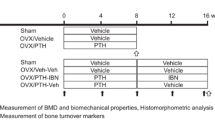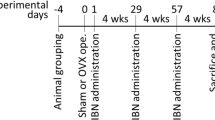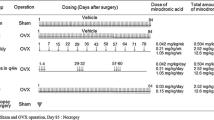Abstract
As part of a long-term safety study the bisphosphonate ibandronate was investigated for its effects on bone quality in lumbar vertebrae in rats. Bone area, bone density and mechanical properties were assessed by peripheral quantitative computed tomography (pQCT), dual-energy X-ray absorptiometry (DXA) and compression tests. Female and male groups of Wistar rats received either vehicle or 3, 7 or 15 mg/kg per day of ibandronate over 104 weeks orally by gavage. Compared with the control group, bone mineral density, compressive strength and stiffness were significantly higher in ibandronate-treated animals, whereas no changes occurred in strain or modulus of elasticity. The increase in vertebral body stress was significant in some of the ibandronate-treated groups. The changes in mechanical properties appear to be due mainly to an increase in bone mass. A highly significant correlation was found between bone mineral density measured either by DXA (r=0.86) or pQCT (r=0.85) and maximal strength in vertebral bodies (p<0.0001 each). In conclusion, we demonstrated that lifelong administration of doses of ibandronate far in excess of any therapeutically intended dose not only increases bone mass and apparent density, but also maintains or even slightly improves bone quality. Bone mineral density measured either by pQCT or DXA can be used as a predictor for ultimate strength in rat lumbar vertebral bodies after treatment with ibandronate.
Similar content being viewed by others
References
Fleisch H. Bisphosphonates in bone disease. 3rd ed. New York: Parthenon Publishing, 1997.
Mühlbauer RC, Bauss F, Schenk R, et al. BM 21.0955, a potent new bisphosphonate to inhibit bone resorption. J Bone Miner Res 1991;6:1003–11.
Bauss F. Ibandronate in malignant bone diseases and osteoporosis preclinical results. Onkologie 1997;20:204–8.
Pecherstorfer M, Herrmann Z, Body J-J, et al. Randomized phase II trial comparing different doses of the bisphophonate ibandronate in the treatment of hypercalcemia of malignancy. J Clin Oncol 1996;14:268–76.
Yoneda T, Sasaki A, Dunstan C, et al. Inhibition of osteolytic bone metastasis of breast cancer by combined treatment with the bisphosphonate ibandronate and tissue inhibitor of the matrix metalloproteinase-2. J Clin Invest 1997;99:2509–17.
Monier-Faugere M-C, Friedler RM, Bauss F, Malluche HH. A new bisphosphonate, BM 21.0955, prevents bone loss associated with cessation of ovarian function in experimental dogs. J Bone Miner Res 1993;8:1345–55.
Bauss F, Kling L, Sponer G. Comparison of continuous and cyclical administration of ibandronate on bone mass in ovariectomized rats. J Bone Miner Res 1996;11(Suppl 1): No. M 618, page S336.
Geng Z, Faugere M-C, Qi Q, Bauss F, Malluche HH. Ibandronate reverses bone loss after cessation of ovarian function in beagle dogs. J Bone Miner Res 1995, 10(Suppl 1): No P283, page S199.
Borchers RE, Gibson LJ, Burchardt H, Hayes WC. Effects of selected thermal variables on the mechanical properties of trabecular bone. Biomaterials 1995;16:545–51.
Dunnett CW. A multiple comparison procedure for comparing several treatments with a control. J Am Stat Assoc 1955;50:1096–121.
Shaffer JP. Modified sequentially rejective multiple test procedures. J Am Stat Assoc 1986;81:826–31.
Guy JA, Shea M, Peter CP, Morrissey R, Hayes WC. Continuous alendronate treatment throughout growth, maturation, and aging in the rat results in increases in bone mass and mechanical properties. Calcif Tissue Int 1993;53:283–8.
Lepola VT, Hannuniemi R, Kippo K, Laurén L, Jalovaara P, Väänänen HK. Long-term effects of clodronate on growing rat bone. Bone 1996;18:191–6.
Mosekilde L, Danielsen CC, Knudsen UB. The effect of aging and ovariectomy on the vertebral bone mass and biomechanical properties of mature rats. Bone 1993;14:1–6.
Toolan BC, Shea M, Myers ER, et al. Effects of 4-amino-1-hydroxybutylidene bisphosphonate on bone biomechanics in rats. J Bone Miner Res 1992;7:1399–406
Li M, Mosekilde Li, Søgaard CH, et al. Parathyroid hormone monotherapy and cotherapy with antiresorptive agents restore vertebral bone mass and strength in aged ovariectomized rats. Bone 1995;16:629–35.
Jowsey J, Riggs BL, Kelly PJ, Hoffman DL, Bordier P. The treatment of osteoporosis with disodium ethane-1-hydroxy-1,1-diphosphonate. J Lab Clin Med 1971;78:574–84.
Jiang Y, Zhao J, Van Audekercke R, Dequeker J, Geusens P. Effects of low-dose long-term sodium fluoride preventive treatment on rat bone mass and biomechanical properties. Calcif Tissue Int 1996;58:30–9.
Fratzl P, Schreiber S, Roschger P, Lafage M-H, Rodan G, Klaushofer K. Effects of sodium fluoride and alendronate on the bone mineral in minipigs: a small-angle X-ray scattering and backscattered electron imaging study. J Bone Miner Res 1996;11:248–53.
Keaveny TM, Hayes WC. A 20-year perspective on the mechanical properties of trabecular bone. J Biomech Eng 1993;115:534–42.
Moro M, Hecker AT, Bouxsein ML, Myers ER. Failure load of thoracic vertebrae correlates with lumbar bone mineral density measured by DEXA. Calcif Tissue Int 1995;56:206–9.
Burr DB. Remodeling and the repair of fatigue damage. Calcif Tissue Int 1993;53(Suppl 1):S75–81.
Flora L, Hassing GS, Parfitt AM, Villanueva AR. Comparative skeletal effects of two diphosphonates in dogs. Metab Bone Dis Rel Res 1980;2(Suppl):389–407.
Author information
Authors and Affiliations
Rights and permissions
About this article
Cite this article
Lalla, S., Hothorn, L.A., Haag, N. et al. Lifelong administration of high doses of ibandronate increases bone mass and maintains bone quality of lumbar vertebrae in rats. Osteoporosis Int 8, 97–103 (1998). https://doi.org/10.1007/BF02672503
Received:
Accepted:
Issue Date:
DOI: https://doi.org/10.1007/BF02672503




